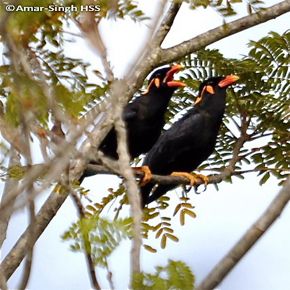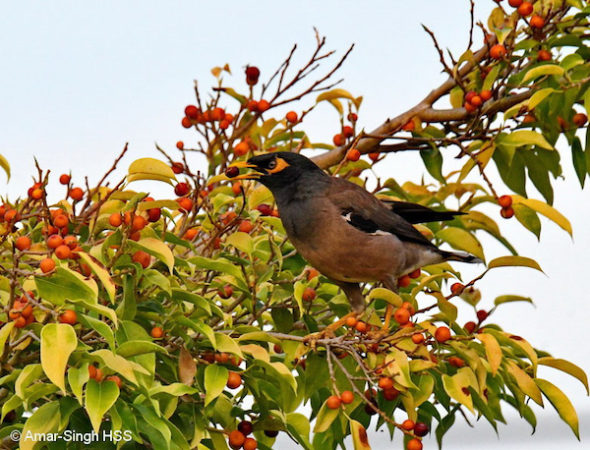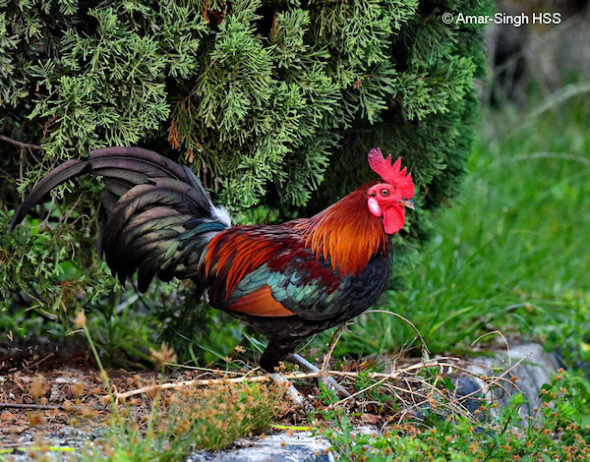

I have often heard some birds mimic the calls of others. When I was a child, I was fascinated by a Common Hill Myna (Gracula religiosa) held captive by a neighbour that had been trained to vocalise some human words. In our garden the Common Myna (Acridotheres tristis) and Oriental Magpie Robin (Copsychus saularis) will produce the occasional interesting variation in calls or songs borrowed from other species.


However, in my experience, the vocal mimic master in the lowland forest is the Greater Racket-tailed Drongo (Dicrurus paradiseus). On many occasions I have been misled and searched long for a babbler or rare sounding bird, only to discover that it is the mimicry of a Greater Racket-tailed Drongo. I have heard them imitate the crowing of a Red Junglefowl (Gallus gallus), the sound of a motorbike engine, and even parts of the call of Black-and-yellow Broadbill (Eurylaimus ochromalus). The video recording (link here: https://youtu.be/nm-8BWqQnaQ, calls start at 15 seconds into the video), taken in January 2020, shows a Greater Racket-tailed Drongo imitating the song of a Pin-striped Tit-Babbler (Mixornis gularis).
Wells (2007) notes that they can mimic various raptors, cuckoos, pittas, waders and a laughingthrush. There is a longer list of bird calls that they mimic in the Birds of the World (Rocamora et al 2020), including woodpeckers, hornbills, babblers, etc.
Hence the question is why do they perform this mimicry of other birds or even of environmental sounds? I have not conducted any study on this and can only rely on personal field observations and the excellent work of others.
The possible reasons for mimicry suggested include (not exhaustive):
- Sexual selection
It is possible that the ability to mimic the song of other bird species makes the male more attractive to the female and enhances the possibility of attracting and getting a mate. This has been postulated for the great mimic, the Australian Superb Lyrebird. Recent work by Dalziell and colleagues (2021) show that Lyrebirds may mimic the sound of ‘mobbing’ flock of birds to ‘trick’ females into mating.
- Improve foraging and feeding efficiency
Goodale and Kotagama (2006) offer data that the Greater Racket-tailed Drongo, mimics the songs and contact calls of other participants of a mixed foraging party to “increase their foraging efficiency”; “overall a mutualistic relationship”. My recording of the Greater Racket-tailed Drongo imitating the song of a Pin-striped Tit-Babbler may be associated with this type of behaviour.
Follows (2021) quotes the use of imitating raptor calls by the Greater Racket-tailed Drongo as means to make other bird fly-off and abandon their food to them.
It is said that some shrikes mimic the calls / songs of some songbirds to attract and feed on them (Atkinson 1997).
Brood parasite juveniles are able to imitate the calls of their host species to encourage feeding.
- Territorial and threat function
There is suggestion that mimicry of calls and environmental sounds may serve a function to establish and maintain territory (Mayntz 2019; The Cornell Lab 2009). The “imitation of the alarm calls of other species … may get the attention of other species to help in the attack of a predator” (The Cornell Lab 2009).
The most comprehensive, recent work on vocal mimicry is by Kelley and colleagues (2008), which attempts to use an evidence-based approach to understanding vocal mimicry. They state that “true vocal mimicry is typically considered to be the acquisition of sounds within an individual’s lifetime” as opposed to “mimicry caused by convergence over generations”. The authors state in their conclusion “we are no closer to determining even a single function for vocal mimicry…. this may, in part, be because of the relative paucity of work…”. “We conclude that there is no compelling evidence to support any of the functional hypotheses but, rather, that almost all of the data concerning song mimicry are consistent with the learning mistakes hypothesis, whereby birds learn simple and common sounds, frequently using them in inappropriate contexts. …. It is plausible that many examples of call mimicry are, in fact, due to evolutionary convergence.”
Much detailed work is still required to understand this interesting behaviour.
References:
- Wells, D.R. (2007). The birds of the Thai-Malay Peninsula: Vol. 2 (Passarines). Christopher Helm, London.
- Rocamora, G., D. Yeatman-Berthelot, and E. de Juana (2020). Greater Racket-tailed Drongo (Dicrurus paradiseus), version 1.0. In Birds of the World (J. del Hoyo, A. Elliott, J. Sargatal, D. A. Christie, and E. de Juana, Editors). Cornell Lab of Ornithology, Ithaca, NY, USA.
- Anastasia H. Dalziell, Alex C. Maisey, Robert D. Magrath and Justin A. Welbergen (2021). Male lyrebirds create a complex acoustic illusion of a mobbing flock during courtship and copulation. Current Biology. Volume 31, Issue 9, page 1970-1976. <https://doi.org/10.1016/j.cub.2021.02.003>
- Eben Goodale and Sarath W. Kotagama (2006). Vocal mimicry by a passerine bird attracts other species involved in mixed-species flocks. Animal Behaviour. Volume 72, Issue 2, pages 471-477.
- Mike Follows (2021). What is the evolutionary advantage of birds’ ability to mimic sounds? New Scientist. Magazine issue 3324, 6 March 2021. <https://www.newscientist.com/lastword/mg24933241-400-what-is-the-evolutionary-advantage-of-birds-ability-to-mimic-sounds/>
- Eric C. Atkinson (1997). Singing for Your Supper: Acoustical Luring of Avian Prey by Northern Shrikes. The Condor. Vol. 99, No. 1. <https://www.researchgate.net/publication/242276103_Singing_for_Your_Supper_Acoustical_Luring_of_Avian_Prey_by_Northern_Shrikes>
- Melissa Mayntz (2019). Bird Mimics and Mimicry: Why Do Birds Use Vocal Mimicry? The Spruce <https://www.thespruce.com/bird-mimics-and-mimicry-386219>
- The Cornell Lab (2009). Why Do Some Birds Mimic The Sounds Of Other Species? <https://www.allaboutbirds.org/news/why-do-some-birds-mimic-the-sounds-of-other-species/#:~:text=The%20female%20Thick%2Dbilled%20Euphonia,predator%20or%20other%20perceived%20threat>
- Laura A. Kelley, Rebecca L. Coe, Joah R. Madden and Susan D. Healy (2008). Vocal mimicry in songbirds. Animal Behaviour. Vol 76, Issue 3, pgs 521-528. <http://cognitioninthewild.wp.st-andrews.ac.uk/files/2013/05/Kelly-2008-Vocal-mimicry-in-songbirds-.pdf>
Dato’ Dr Amar-Singh HSS
Ipoh, Perak, Malaysia
Note to readers: If you like this post please tap on the Like button at the left bottom of page.








